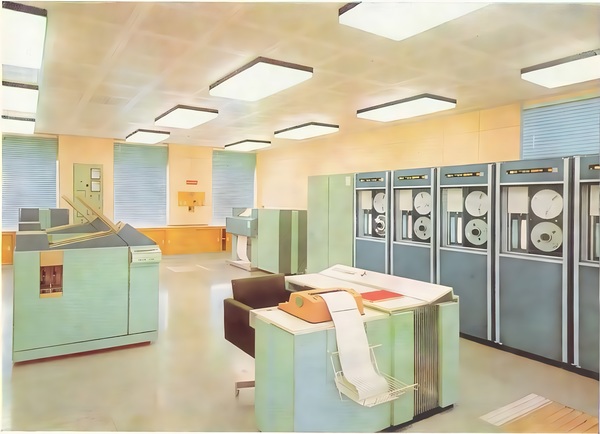TESLA 200
 It was manufactured from 1966 by VHJ TESLA.
The computer was inspired by or was successor to Gamma 140/145.
It was manufactured from 1966 by VHJ TESLA.
The computer was inspired by or was successor to Gamma 140/145.
The Tesla 200 series computers were designed primarily for the processing of bulk data. However, the universal central unit also made it possible to solve scientific and technical and mathematical-economic calculations. The extensive range of peripheral devices was based on the demands of practice. The Tesla 200 series computers allowed real -time calculations to be directly transmitted. The Tesla 200 series computers used standard interfaces. They are compatible with magnetic tape with other computers oriented to a nine -track magnetic tape.
- Tesla 230
- Tesla 270
The types differ in each other cycle and the capacity of the memory. Each type can be assembled in a wide range of peripheral configuration.
TC2 technology
The intermediate stage of the development of the structure and technology of logical circuits between classic plates with printed joints and integrated circuits is the TC2 technology (“technology de Commutation à deux couches”-two-level connection technology; used in Bull-Ge).
Two -levels are marked by the perimeters of sum and product gates. These gates are connected immediately. Impulses coming from generators (flip -flops, electromechanical, etc.) are fed to the product that evaluates the inputs and creates the resulting signal on the input of the sum. All these circuits are realized at a negative voltage level for a logical number one. Individual active circuits (logical gate, amplifiers, etc.) are located on common plates with printed joints.
The circuits are designed to apply the following logical levels at the outputs and interconnections of active circuits:
| Output: | Connection: | Practice |
| Logical "1" = –0.2 V | logical "1" = –0.5 V | for logical "0": –4.5 to –12 V |
| Logical "0" = –0.8 V | logical "0" = –12 V | For logical "1": –0.2 to –0.8 V |
Power: +10 V, -12 V, -4.5 V, -0.2 V
The motherboard made of artificial epoxy resin has dimensions of 127 × 177 mm.
The output for the connector contains 44 outlets, of which 40 are used to connect signals.
To this board are perpendicularly attached smaller plates with printed joints (115 × 15 mm) on which they are located:
- Resistors of the product of the product,
- Logical active circuits.
The following logical circuits are realized by TC2 technology:
- Amplifier A - amplifies and inverts the input signal.
- Amplifier H - has three different functions according to use (eg with switching outputs).
- Flip circuit B - bistable flip -flop circuit with output of 1 bit, in addition to direct output has an inverted output.
- Flip circuit AB1 - with logical change, used to process signals from selection circuits.
- TC3 is more advanced than TC2 - offers higher integration density and easier connection because logic has direct outputs.
- On one motherboard there is 1–12 so -called millimodules, each with dimensions of 32 × 23 × 15 mm.
- Milimodul consists of three parts: basic resin (with outlets), bushings with fasteners and plexiglass boards, which ensures mechanical and electrical connection.
- The elements consist of transistors (2-8), diodes, capacitors and resistors, in various combinations up to 59 components per module.
- All circuits are powered by a single +6 V voltage, the logical "1" corresponds to the positive voltage.
- Connection is done directly by soldering wires, newer versions use the soldered outlets instead of interlaging pins.
- Used transistors are silicon, rectifier diodes, ceramic capacitors.
- It is a type of magnetic memory where the support conductor is covered with a thin layer of permalloye (~ 1 µm).
- There are wounded and enrollment coils around the conductor.
- The carrier conductor represents a line of bits in all words of memory.
- Writing and reading takes place - read current about 40 mA, notation 60 mA and select current around 500 mA.
- The ends of the wires are led to amplifiers.
- Consists of four boards, each with a capacity of 32 words × 20 bits.
- The supporting wires with the magnetic layer are stretched horizontally, the selection wires vertically.
- Each selection wire is intertwined around the supporting conductors and creates a 1.5 thread, allowing reliable write and reading.
- Four boards together form a complete memory and are connected to the selection matrics.
- The TC3 matrix also serves as a mechanical protection of memory plates.
- Memory is used as a leveling ("Scratch-Pad")-for short-term storage of data in calculations.
Software
The Tesla 200 is equipped with a modern operating system that largely automates the operation and use of the machine. It includes supervisory programs (supervisor, monitor), APS programming languages, Tesla Fortran, Tesla Algol, Tesla COBOL, Tesla Format, Tesla compita and a number of operating programs. In addition, the computer is equipped with a wealth of application programs.
References
- http://prog-story.technicalmuseum.cz/data/dataservis/tesla-200.pdf (WebArchive)
- http://prog-story.technicalmuseum.cz/index.php/m-virtualni-sbirka-tm-v-brne/odborne-konference-tm-v-brne/2019-50-let-pocitace-tesla-200/5102-pocitace-tesla-200-300-vyroba-1969-az-1978 (WebArchive)
- http://prog-story.technicalmuseum.cz/index.php/m-virtualni-sbirky-tm-v-brne/interni-autorske-texty/196-vs-ingstav-brno-v-dokumentech/2571-1970-1987-osmnact-let-se-salovym-pocitacem-tesla-200 (WebArchive)
- http://prog-story.technicalmuseum.cz/index.php/m-virtualni-sbirky-tm-v-brne/vs-ingstav-brno-v-dokumentech/3837-1989-kombinovany-davkove-interaktivni-projekt-materialove-agendy-velkeho-stavebniho-podniku (WebArchive)
- Tesla Lanškroun (firma) a Jiří KOHOUT. Tesla Lanškroun 1946-1989: vzpomínky pamětníků. Lanškroun: Městské muzeum Lanškroun, 2007, s. 65. ISBN 978-80-254-0835-3. Dostupné také z: https://ndk.cz/uuid/uuid:8ce0d010-fa0a-11e7-9854-5ef3fc9ae867
- https://web.archive.org/web/20110704023118/http://www.galaxie.name/index.php?clanek=pribeh-pocitace-4-dil (WebArchive)
- http://prog-story.technicalmuseum.cz/index.php/m-virtualni-sbirka-tm-v-brne/vetsi-souhrnne-komplety/dataservis-zpravodaj-uvt-tesla/1978-zpravodaj-uvt-tesla/2572-1978-instalace-pocitacu-tesla-200 (WebArchive)
- https://www.matfyz.cz/clanky/zavod-pocitacu-epos-2-vs-tesla-200 (WebArchive)